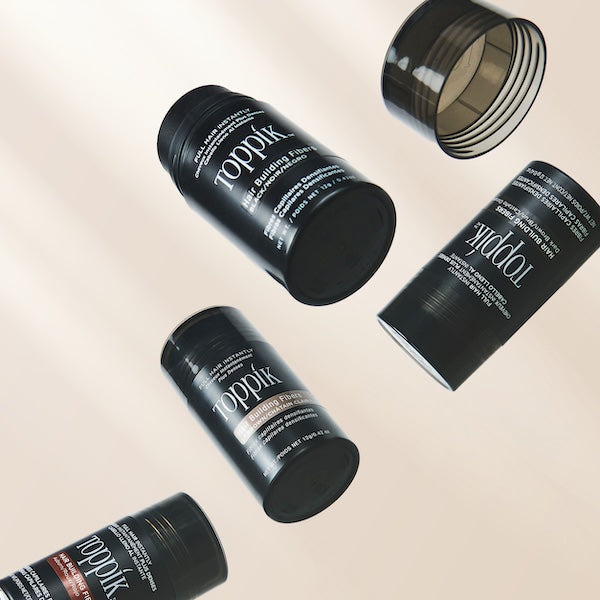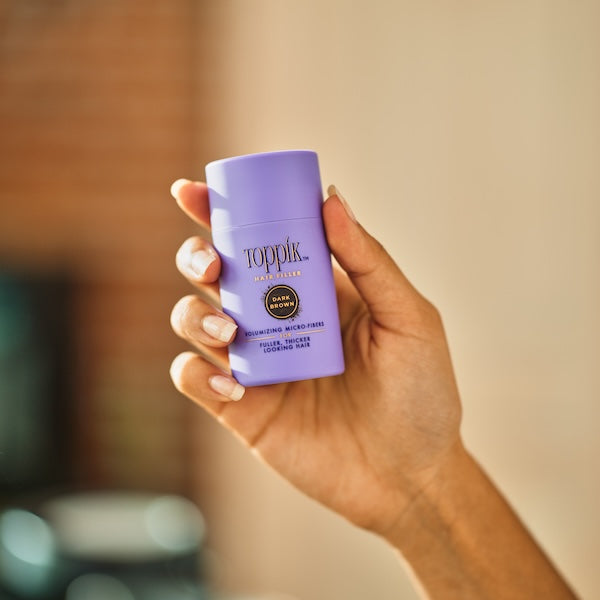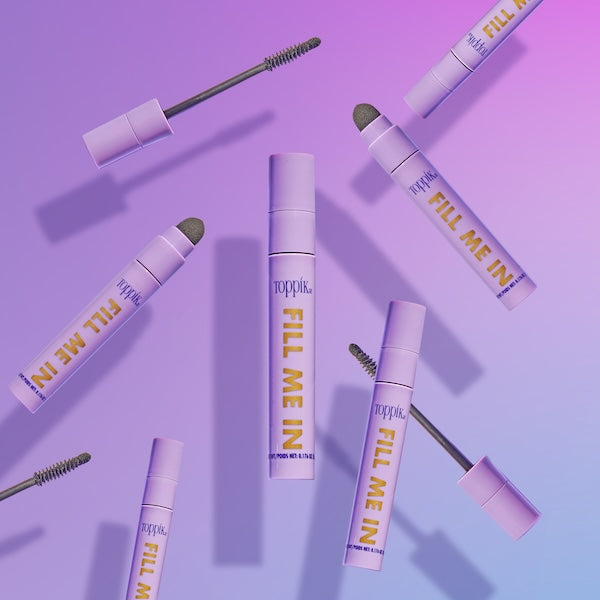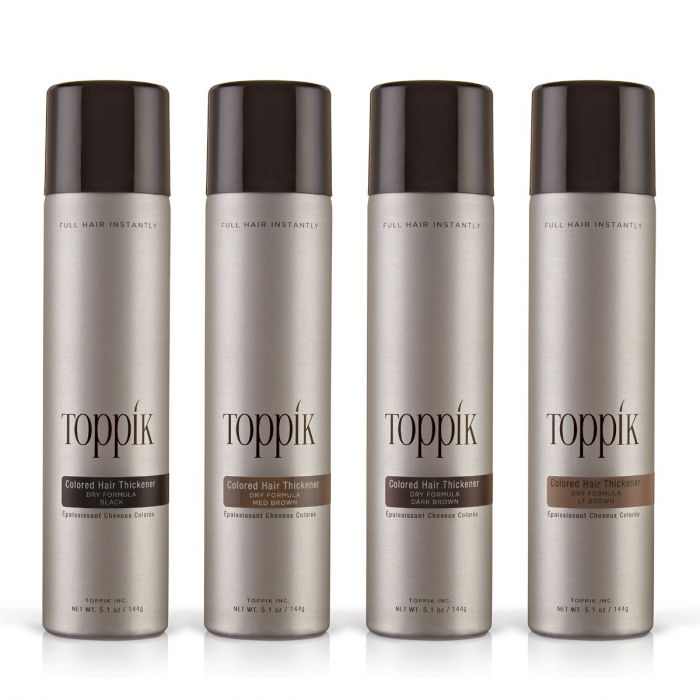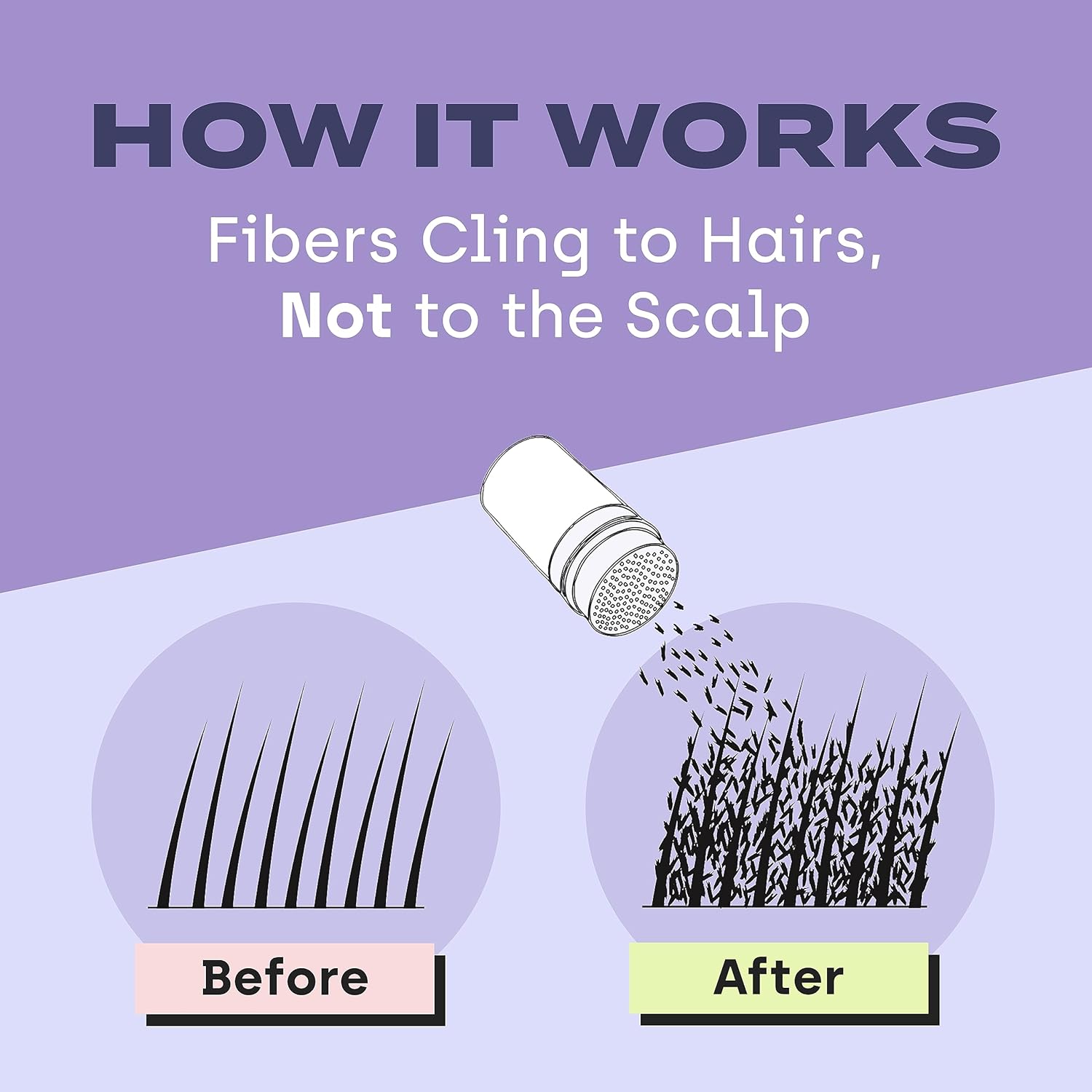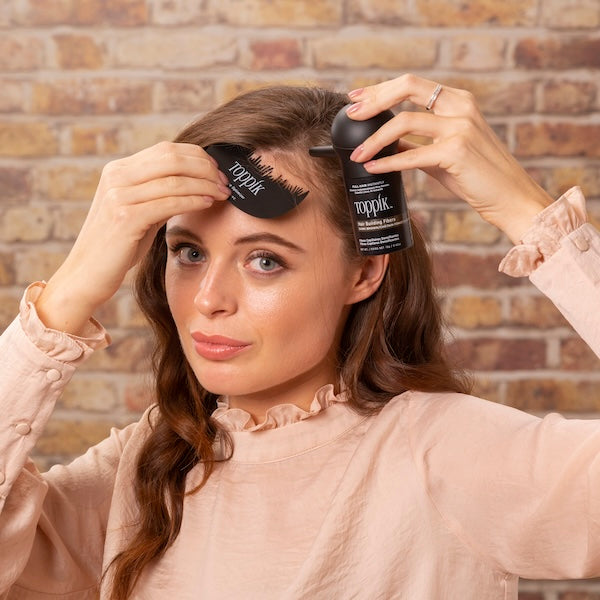Men’s Hair Loss
If you’re struggling with men’s hair loss, you’re not alone. According to the American Hair Loss Association, about 85% of men will have significant hair thinning by the time they turn 50, and 25% of men with hair loss begin losing hair before the age of 21. Hair loss can have a massive impact on a man’s life, affecting his physical appearance and self-esteem.
The good news is that there are solutions to conceal and even regrow thinning hair. The key is to know what type of hair loss you’re experiencing, what’s causing it, and the different treatment options available to you.
Whether you’re looking to regrow hair, cover up hair loss, or make your hair look thicker and fuller, Toppik can provide you with the best solutions, while also helping to educate you on the science behind what is happening and your options.
Read on to learn more about men’s hair loss and the different treatments available for hair regrowth for men.
What Is Hair Loss?
Hair loss, medically known as alopecia, is a common condition characterized by the thinning or complete loss of hair from areas where it normally grows. By age 35, approximately two-thirds of American men will experience some degree of appreciable hair loss.
Understanding the types of hair loss and causes of hair loss is essential for effective treatment. Different forms of hair loss respond to different treatments, and misdiagnosing the type can lead to ineffective interventions. For this reason, it’s important to talk to a dermatologist or trichologist if you are concerned about men’s hair loss.

Types of Hair Loss in Men
As we mentioned before, understanding the type of hair loss you’re experiencing is key to finding an effective solution. Here are the four most common types of hair loss:
Involutional Alopecia
What It Is: A natural condition where hair gradually thins with age.
Cause: More hair follicles enter the "resting" (telogen) phase, reducing active growth. As a result, hair regrowth becomes more difficult over time.
Symptoms: Shorter hair growth cycles and reduced density over time.
Androgenetic Alopecia (Male Pattern Baldness)
What It Is: Also known as male pattern baldness, androgenetic alopecia is responsible for over 95% of hair loss in men.
Cause: Men who suffer from male pattern baldness have actually inherited hair follicles that have a genetic sensitivity to dihydrotestosterone (DHT). DHT shortens the lifespan of the affected hair follicles, and eventually stops the production of hair. It can affect both men and women, but is more common in men. Men can experience this type of hair loss as early as their teens or early 20s.
Symptoms: Receding hairline, thinning at the crown.
Further reading: What Is DHT and Male Pattern Baldness?
Alopecia Areata
What It Is: Alopecia areata is an autoimmune skin disease that results in hair loss on the scalp and elsewhere on the body.
Cause: It occurs when the immune system mistakenly attacks hair follicles, which is where hair growth begins. It is often not permanent, and experts do not know the cause of the attack on the hair follicles.
Symptoms: Small, round patches of visible and exposed scalp on top of the head. People with a limited number of patches may experience full hair regrowth within a couple years, though 30% of individuals with alopecia areata may experience persistent hair loss.
Telogen Effluvium
What It Is: Telogen effluvium is a temporary form of hair loss caused by stress.
Cause: It is caused by a large number of hairs entering the telogen or “resting” phase at the same time, usually from a physical or emotional stress. A couple months later, these follicles will transition to the exogen phase, and a significant amount of shedding will occur. The good news is that if the stressor is resolved, hair regrowth should naturally occur.
Symptoms: Allover thinning a few months after a stressful event.
How do I know what type of hair loss I have?
The best way to find out what type of hair loss you have is to consult a dermatologist.

What Causes Hair Loss in Men?
There are many causes for hair loss, but luckily, hair regrowth or hair loss prevention is possible for some men.
Medical Conditions
Men’s hair loss can be a symptom of many medical conditions, such as thyroid disease, lupus, anemia, and eating disorders. Once the underlying problem is treated, in many cases, the hair will return.
Dietary Deficiencies
A balanced diet is key to good health. If the body isn’t getting enough essential vitamins, minerals, and nutrients, then the body’s organs, tissues, and cells (including hair follicles) may not function properly. Protein, iron, zinc, and biotin deficiencies have all been linked to hair loss in men. In addition to deficiencies, having too much of certain nutrients, such as vitamin A, can also cause premature male pattern baldness.
Tip: Maintain a balanced diet rich in vitamins and minerals to help prevent hair loss and support healthy hair growth.
Stress
You probably already know that stress isn’t good for your body, but did you also know it’s not good for your hair? Both short-term and long-term stress can contribute to men’s hair loss. Luckily, once the stressor is resolved, hair regrowth usually occurs.
Hormonal Changes
Dihydrotestosterone (DHT) shortens the growth cycle of your hair and increases the resting phase. Over time, hair begins to grow less and becomes smaller in diameter until it stops growing altogether. Unfortunately, genes can make certain hair follicles (usually in the front and crown of the head) especially sensitive to this hormone. Furthermore, excess levels of testosterone often result in higher levels of DHT and therefore an increase in hair loss or baldness.
Genetics
More than 95% of male hair loss is due to male pattern baldness, which is genetic. Contrary to popular belief, this gene can come from either parent. Unfortunately, this type of hair loss is impossible to prevent, but there are men’s hair growth treatments that, when used early enough in the hair loss process, can help counteract the genetic trait and prevent men’s hair loss.
Men’s Hair Loss Treatment Options
Hair Regrowth Treatments
When it comes to hair regrowth for men, several clinically-proven options exist, including minoxidil. Minoxidil is a widely-used, FDA-approved topical treatment. Minoxidil works as a vasodilator, expanding blood vessels and increasing blood flow to hair follicles. This enhanced circulation delivers more nutrients and oxygen to the follicles, potentially revitalizing those that have become dormant.
Covering Thin or Thinning Hair
For instant coverage, try products like keratin-based hair fibers. We recommend Toppik Hair Building Fibers to instantly create the appearance of thicker-looking hair. Made of colored keratin fibers with a natural electromagnetic charge, Toppik Hair Building Fibers cling to your existing hair to make it look thicker and fuller. These natural-looking hair fibers will stay in your hair through wind, rain, and perspiration, but will easily wash out with shampoo. This makes Hair Building Fibers the simplest and quickest way to cover up thinning hair.
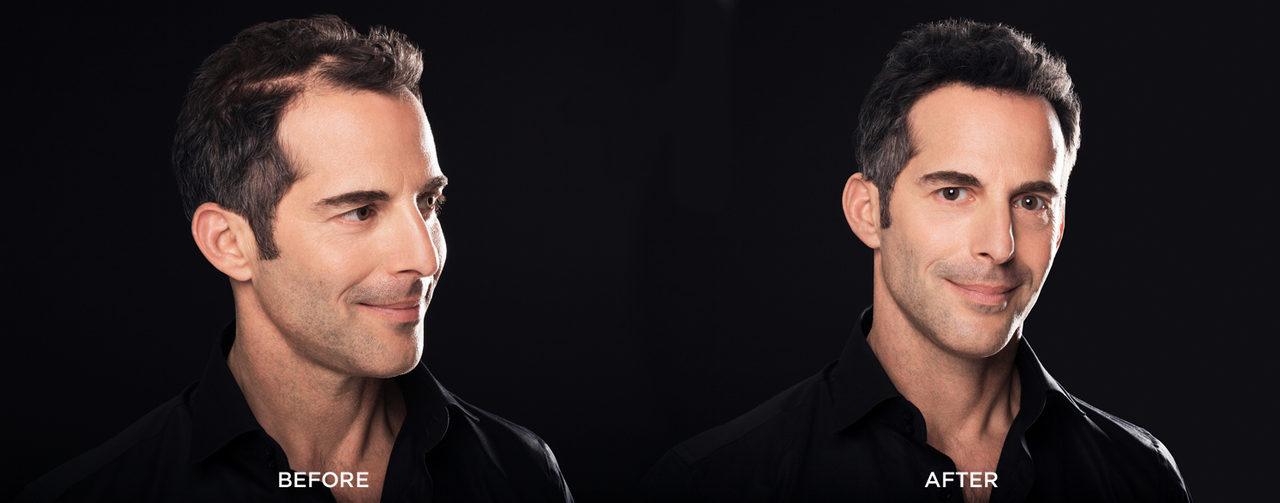 Solutions for Bald Spots
Solutions for Bald Spots
If you have larger areas of hair loss, scalp show-through, or even bald spots, you will need a bald spot solution. Toppik Colored Hair Thickener is a colored hair thickening spray that instantly makes thinning hair look thick and full. It fills in thinning hair while also covering bald spots, and won’t rub off until you wash your hair with shampoo.
Here is what some of our customers had to say about Toppik Colored Hair Thickener:
-
“This product has been a life saver. After trying out many products and never finding anything that worked, I never thought I would find anything that would work this well.”
-
“Best product on the market for my severe male pattern hair loss.”
-
“This product really works well to cover my thinning hair. I would recommend this to anyone who has a problem with thinning hair. I love it!!”
What medical treatment can help with hair loss?
Other medical treatments like platelet-rich plasma therapy (PRP), hair transplants, and finasteride are also available. Though they can be pricey, they can also be effective and may be worth discussing with your doctor.
How to Prevent Hair Loss in Men
Hair loss prevention begins long before you notice the first signs of thinning. By implementing certain lifestyle modifications and being proactive about hair health, many men can slow down the progression of hair loss and maintain healthier hair for longer periods. The following are evidenced-based approaches to help prevent hair loss and promote stronger, healthier hair.
Eat a Hair-Healthy Diet
A balanced diet rich in essential nutrients serves as the foundation for hair health. Your hair follicles require specific vitamins and minerals to function optimally, including:
Protein – Hair is primarily made of protein, making adequate intake crucial. Include lean meats, fish, eggs, and plant-based proteins in your diet.
Iron – Iron deficiency is linked to hair loss, so incorporate iron-rich foods like spinach, lentils, and red meat.
Omega-3 Fatty Acids – Found in fatty fish, walnuts, and flaxseeds, these reduce inflammation and support hair density.
Vitamins A, C, D, and E – These antioxidants protect hair follicles from oxidative stress and support the production of sebum, your scalp’s natural conditioner.
B Vitamins – These nutrients strengthen hair.
Follow Stress Management Tactics
Chronic and acute stress triggers hormonal imbalances that can accelerate men’s hair loss. Implementing stress reduction techniques not only benefits your overall health but directly impacts hair retention:
-
Regular physical activity releases tension and improves circulation to the scalp
-
Mindfulness practices like meditation reduce cortisol levels.
-
Adequate sleep allows for proper cellular repair.
-
Setting healthy boundaries helps with work-related stress.
-
Social connections provide emotional support.
Further reading: Can Stress Cause Hair Loss?
Intervene Early
Perhaps the most crucial healthy hair tip is recognizing that early action yields the best results. Most men wait until they’ve already lost a significant amount of hair before seeking treatment, but the most effective time to prevent hair loss is when you first notice changes:
-
Schedule a dermatologist consultation at the first signs of increased shedding.
-
Talk to your doctor about preventive measures if you have a family history of baldness, even if you’re not currently noticing hair loss.
-
Document your hairline with photos every few months to track subtle changes.

Is there a hair loss cure?
Though there are many treatments for preventing hair loss and hair regrowth, there is no cure for male pattern baldness.
Why Choose Toppik Products?
Toppik has built a strong reputation among celebrity stylists as Hollywood’s best-kept secret. Since its inception, Toppik has changed the lives of millions, giving them the confidence and youthful appearance that comes with having a full, thick head of hair.
We have several products that provide instant cosmetic fixes for thinning hair, including:
Check out Toppik reviews for our customers’ testimonials and success stories:
“I love Toppik. I'm 32 years old and I’ve been using it for 8 years. When I first discovered it I couldn’t believe how well it concealed my bald spots. I have very fine thin hair. It’s genetic. But this product gives me so much confidence. There’s not a day I don’t use it! Super worth it! It looks super natural! I’ve never NEVER had anyone ask me if there’s something in my hair. No one notices it and that’s why I’m a huge fan of this product.”
“Toppik is a life saver for me. I won’t leave my house without using it. My hairdresser first told me about Toppik more than 10 years ago and I’ve been using it ever since. Toppik is the best hair filler I’ve ever used. If you’re looking for a way to instantly disguise thinning hair or hair loss, try Toppik!”
Conclusion
Hair loss affects most men, with 85% experiencing significant thinning by age 50. In this article, we’ve explored various types of hair loss and their causes, including genetics, hormones, stress, and nutrition. We’ve also shared effective solutions ranging from FDA-approved minoxidil and Toppik’s instant cosmetic products. Remember: hair loss isn’t inevitable. With early intervention and prevention tactics, countless men have extended their years of healthy hair.
Curious about Toppik’s instant solutions for thinning hair? Check out our website today to explore our innovative styling products, read success stories, and find the perfect product for your needs.
This article was originally published on January 9, 2015. It has been updated with new information.

